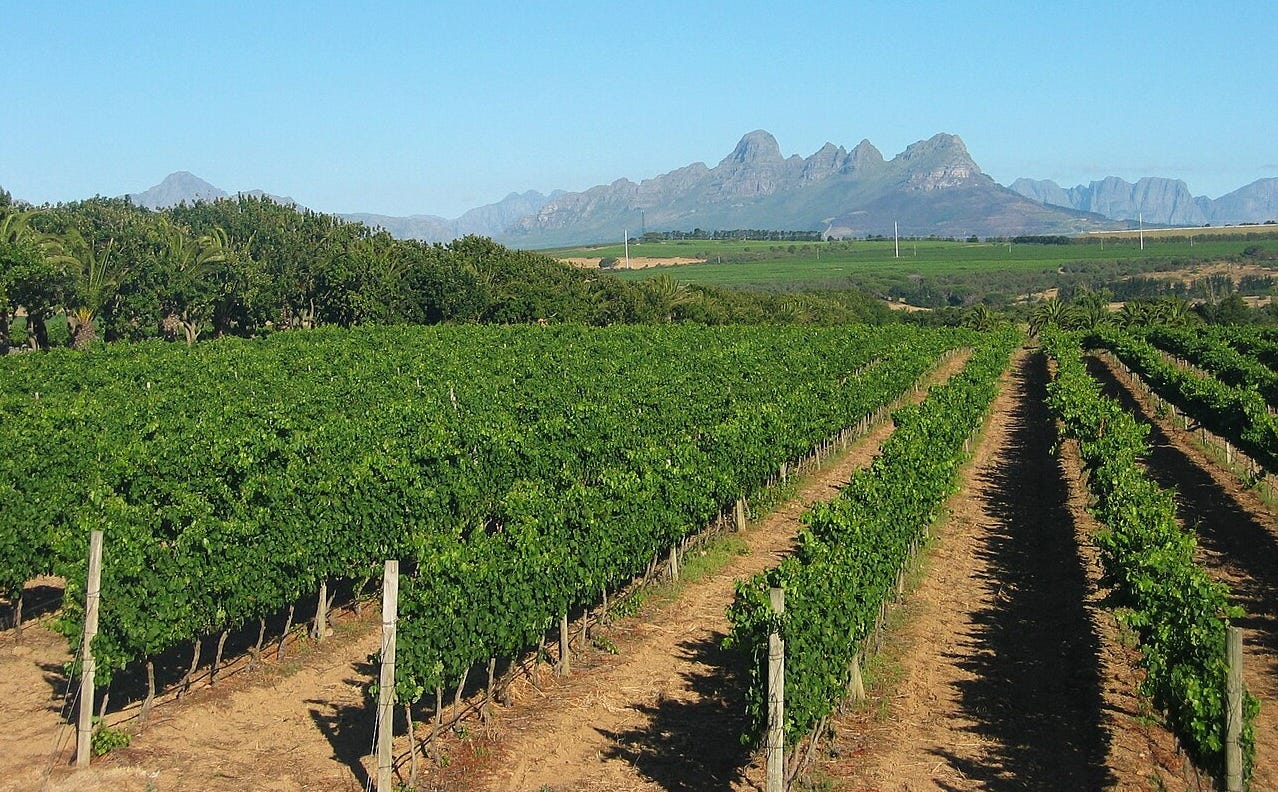Stellenbosch is arguably South Africa’s commercially most significant wine region. Located just east of Cape Town, it serves as a cornerstone of the country’s wine industry in terms of volume, academic research, and international market recognition. With a mix of maritime influence, varied soils, and a long viticultural history, Stellenbosch is a versatile wine-growing zone capable of producing a wide range of styles.
Historical Background
Viticulture here dates back to the late 17th century, following the arrival of Dutch settlers and subsequently French Huguenots, who brought winemaking knowledge and grapevine cuttings to the Cape Colony. The fertile soils and Mediterranean-style climate made Stellenbosch a suitable location for grape cultivation, and by the 18th century, it had established itself as a key contributor to South African wine production.
Throughout the 19th and 20th centuries, the region saw shifts in vineyard management, production methods, and export strategies, particularly following the formation of the Koöperatieve Wijnbouwers Vereniging (KWV) in 1918, which regulated wine quality and exports. The end of apartheid in the early 1990s opened international markets to South African producers, prompting increased investment and modernization in Stellenbosch’s wine sector.
Grape Varieties and Wine Styles
Stellenbosch’s climate is classified as warm Mediterranean, moderated by Atlantic Ocean breezes from False Bay. This allows for the cultivation of both red and white grapes, although red varietals strongly dominate.
Red Grapes
-
Cabernet Sauvignon: The most planted and commercially important red grape in the region. Often used for varietal wines and blends, particularly in Bordeaux-style combinations.
-
Merlot: Commonly paired with Cabernet Sauvignon to soften blends, or bottled on its own.
-
Shiraz (Syrah): Frequently made in a ripe, full-bodied style; also appears in Rhône-style blends.
-
Pinotage: A uniquely South African grape, developed from a cross between Pinot Noir and Cinsaut. While polarizing in style and reception, it remains a regional staple.
White Grapes
-
Chenin Blanc: Although more associated with regions like Swartland, it is still grown in Stellenbosch and used for both dry and off-dry styles.
-
Sauvignon Blanc: Typically planted in cooler subzones, producing wines with herbal and citrus-driven profiles.
-
Chardonnay: Made in both oaked and unoaked versions, sometimes used in sparkling wines (Cap Classique).
The range of microclimates and soils within Stellenbosch range from granite and shale to sandstone and support the production of both single-varietal wines and complex blends.
Subregions
Stellenbosch is not a monolithic zone; it comprises several wards or subregions, each with distinct characteristics. Notable among these are:
-
Simonsberg-Stellenbosch: Known for structured reds.
-
Jonkershoek Valley: Cooler climate; suitable for Sauvignon Blanc and Cabernet-based wines.
-
Helderberg: Coastal influence; diverse plantings.
-
Bottelary Hills: Often associated with Pinotage and Shiraz.
These subregions allow for differentiated branding and marketing within the greater Stellenbosch designation.
Leading Producers
The region includes a mix of large-scale operations and smaller, privately-owned estates. While it is difficult to definitively rank producers, the following five are widely recognized within the trade for their historical significance, consistent quality, and international distribution:
-
Kanonkop Estate
Known for its long-standing commitment to Pinotage and Bordeaux blends. Family-owned since the early 20th century. -
Meerlust Estate
One of the first to label a Bordeaux-style blend as “Rubicon,” which became a flagship South African wine. -
Rust en Vrede
Focused almost exclusively on red wine. Frequently cited for its Shiraz and Cabernet Sauvignon. -
Warwick Estate
Known for its trilogy of Bordeaux-style blends and experimentation with single-varietal expressions. -
Spier Wines
One of the region’s oldest wine farms, combining large-scale production with a sustainability focus.
These producers vary in scale, but all have built international reputations based on consistent branding and quality.
Export Markets and Global Reception
Stellenbosch plays a central role in South Africa’s wine exports. Key markets include the United Kingdom, Netherlands, Germany, the United States, and China. The wines are often priced competitively compared to similar quality offerings from Europe and the New World, making them appealing to both on-trade and off-trade buyers.
Reception in global markets has generally been positive, especially in blind tastings where Stellenbosch reds frequently perform well. Cabernet Sauvignon and Bordeaux-style blends are the most likely to appear on international wine lists, while Sauvignon Blanc and Chenin Blanc hold appeal in retail environments.
Despite its relative success, the region still faces challenges such as currency fluctuation, vintage variation due to droughts, and residual perception issues in some markets tied to its apartheid-era legacy. Nonetheless, Stellenbosch remains one of South Africa’s most internationally visible appellations.
Image Credit: https://wikipedia.org
_ _ _
© CHURRASCO PHUKET STEAKHOUSE / ALL RIGHTS RESERVED
Reprinting, reposting & sharing allowed, in exchange for a backlink and credits
Churrasco Phuket Steakhouse serves affordable Wagyu and Black Angus steaks and burgers. We are open daily from 12noon to 11pm at Jungceylon Shopping Center in Patong / Phuket.
We are family-friendly and offer free parking and Wi-Fi for guests. See our menus, reserve your table, find our location, and check all guest reviews here:
https://ChurrascoPhuket.com/
#Churrascophuket #jungceylon #phuketsteakhouse #affordablewagyu #wagyu

